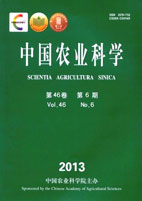-
Effects of High Molecular Weight Glutenin Subunits on Wheat Quality by Aroona and Its Near-Isogenic Lines
- JIN Hui, HE Zhong-Hu, LI Gen-Ying, MU Pei-Yuan, FAN Zhe-Ru, XIA Xian-Chun, ZHANG Yan
-
Scientia Agricultura Sinica. 2013, 46(6):
1095-1103.
doi:10.3864/j.issn.0578-1752.2013.06.002
-
 Abstract
(
852 )
Abstract
(
852 )
 PDF (485KB)
(
890
)
PDF (485KB)
(
890
)
 Save
Save
-
References |
Related Articles |
Metrics
【Objective】The effects of high molecular weight glutenin subunits (HMW-GS) on dough properties, quantity of gluten protein fractions, and bread-making quality were determined under the same genetic background of low molecular weight glutenin subunits (Glu-A3c, Glu-B3b, Glu-D3c). 【Method】Near-isogenic lines (NILs) developed from Australian cultivar Aroona planted in Urumqi and Shihezi in Xijiang during the 2010 cropping season were used to investigate Farinograph, Extensograph, quantity of gluten protein fractions, and bread-making quality. 【Result】The effect of HMW-GS on extensibility was not significant. For dough strength, different HMW-GS loci were ranked as Glu-D1>Glu-B1>Glu-A1 and the subunit pairs 7+9, 17+18, and 5+10 were correlated with superior dough strength. The line with 1, 7+9, 5+10 performed the best dough strength while those with 2*, 7+9, 2+12 and 1, 7+9, 2.2+12 were associated with superior extensibility. For the percent of SDS-unextractable glutenin polymeric protein (%UPP), different HMW-GS loci were ranked as Glu-D1>Glu-B1>Glu-A1 and the subunit pairs 7+9, 17+18, and 5+10 exhibited the highest %UPP. The line with 1, 7+9, 5+10 was associated with the highest %UPP. For bread-making quality, different HMW-GS loci were ranked as Glu-D1>Glu-A1>Glu-B1 and the subunits 1, 2*, 2+12, and 5+10 showed the higher total score. The line with 1, 7+9, 2+12 had the highest total score, 1, 7+9, 5+10 showed the second highest total score, and null, 7+9, 2+12 displayed the lowest total score.【Conclusion】The effects of HMW-GS on dough strength, quantity of gluten protein fractions, and bread-making quality were significant under the same genetic background of LMW-GS (Glu-A3c, Glu-B3b, Glu-D3c); Subunits 1, 2*, 7+9, 17+18, and 5+10 were correlated with superior wheat quality and the line with 1, 7+9, 5+10 is ideal for improving bread-making quality.









